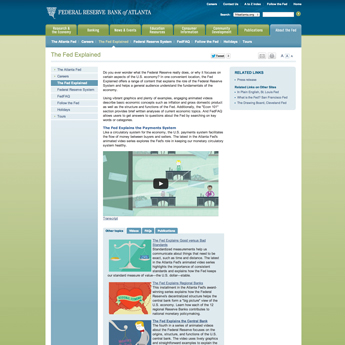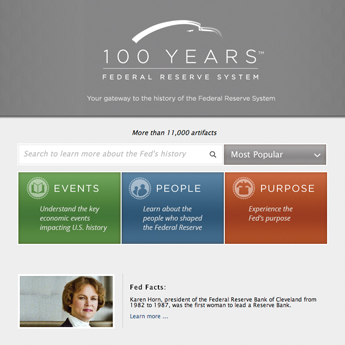The financial turmoil of 2007-08 has deeply affected our nation's households and businesses. What began as a nationwide housing downturn has led to a national and global financial crisis with serious consequences for the real economy. In his Oct. 20 testimony to the House Budget Committee, Federal Reserve Chairman Ben Bernanke summarized the situation as follows:
[T]he turmoil is the aftermath of a credit boom characterized by the underpricing of risk, excessive leverage, and an increasing reliance on complex and opaque financial instruments that have proved to be fragile under stress. A consequence of the unwinding of this boom and the resulting financial strains has been a broad-based tightening in credit conditions that has restrained economic growth.1/
Historians of the Great Depression have criticized that era's policymakers—including the Fed—for responding too late and in too limited a fashion. Determined not to repeat those mistakes, and convinced that bold initiatives can improve credit markets, build confidence and restore financial stability, Chairman Bernanke and the Fed have taken vigorous steps to reestablish normal credit channels and flows. Indeed, the speed and breadth of the Fed's response have been unprecedented in both the extension of existing programs and the creation of new ones.
These actions to inject liquidity and thereby stabilize credit and financial markets are not the first of their kind, however. Several of them build upon traditional Fed tools. Others, particularly those taken since March 2008, represent a rapid expansion of nontraditional lending programs and efforts authorized under Section 13(3) of the Federal Reserve Act.
Given the large number of initiatives launched or expanded in recent months, a summary review of actions undertaken by the Fed may be useful. With that goal in mind, this article consists of three parts.
- First, it discusses the aggressive modification and use of traditional Fed programs and tools to provide liquidity that have taken place over the past year.
- Second, it describes a new set of nontraditional programs and actions that have been serially implemented, beginning in March and expanding over the past several months as the crisis gained momentum.
- Lastly, the article attempts to quantify the magnitude of the overall Fed response by describing the effect of these actions on the size and composition of the Fed's balance sheet.2/
I. Aggressive use of traditional programs to provide liquidity
A. Monetary Policy
One of the Fed's central functions is the development and execution of monetary policy on behalf of the United States. In evaluating the appropriate monetary policy stance, the Federal Reserve considers the "dual mandate," established by Congress, of price stability and maximum employment. Policymakers conduct monetary policy through (1) open market operations, (2) the discount rate and (3) reserve requirements.
Using these tools, the Fed influences the demand and supply of balances at the Fed, and ultimately shifts the actual federal funds rate toward the target set at meetings of the Federal Open Market Committee. The federal funds rate is the interest rate at which depository institutions make overnight loans from their balances at the Federal Reserve Banks to other depository institutions. The federal funds rate is important because it affects short- and long-term interest rates that businesses and individuals pay.
As liquidity pressures on financial markets increased from late 2007 through 2008 (see “Measuring Perceived Risk—The TED Spread"), the Fed acted aggressively by lowering the target federal funds rate to mitigate the risk that decreased liquidity would excessively dampen economic activity.
The overall reduction in the target federal funds rate since late 2007 has been dramatic, going from 5.25 percent in September 2007 to a range of 0 percent to 0.25 percent on Dec. 16, 2008. To be clear, as in the past, reductions in the target federal funds rate may not result in exactly parallel movements in interest rates available to individuals and businesses, but they have kept most interest rates lower than they would otherwise have been.
At the same time, bank borrowing has also been made more affordable by reducing the spread between the target federal funds rate and the primary credit rate (the rate the Fed charges banks in good condition). This spread was 100 basis points as of early-August 2007, meaning that in general, banks could borrow much more cheaply from the interbank market (where banks lend to one another) than from the Fed. Since mid-August 2007, the Fed has narrowed the spread to a mere 25 basis points to provide a ready source of liquidity to healthy financial institutions.
The actions to lower bank costs of borrowing by reducing the spread are a significant step, though simply a modification of traditional Fed programs. As a result, the rate offered to banks is still an above-market rate, although modestly so. As recently as 2002, banks could actually borrow from the Fed at a below-market rate, although credit was administered by more closely reviewing banks' funding situations and the Fed monitoring the use of funds lent to banks.
The Federal Reserve requires that depository institutions maintain a particular amount of funds (reserves), in the form of either vault cash or deposits with Federal Reserve Banks. Congress, through the Emergency Economic Stabilization Act passed in early October 2008, permitted the Federal Reserve to pay interest on required reserve balances and excess balances. The payment of interest on reserves permits the Federal Reserve to expand its balance sheet as necessary to provide the liquidity needed to support financial stability while implementing the appropriate monetary policy.
B. Enhancements to existing liquidity programs—Credit programs and swap linesThe Fed's enhancement of traditional programs has not been limited to monetary policy (open market operations, the discount rate and reserve requirements). The Fed has also significantly expanded its liquidity facilities. These facilities, in particular the discount window, have long been a source of backup liquidity for financial institutions. Until recently, though, discount window lending has been relatively limited in scale, except in short periods of credit tightening such as post 9/11. This was because of three factors: (1) the Fed's rates were generally higher than those available in the interbank market; (2) some financial institutions viewed borrowing from the Fed as a sign of weakness; and (3) financial institutions and the Fed positioned Fed discount window borrowing as a backup to other bank borrowing.
Since late 2007, the Fed has moved from a secondary to a primary source of liquidity. (See “Actions to Increase Credit Availability”.) This move began with the narrowing of loan pricing available from the Fed, as noted above. But a more significant enhancement was the Term Auction Facility, a facility implemented in December 2007 to provide term funding to banks (currently up to 84 days) through overlapping competitive auctions. The TAF has been highly utilized by banks—the amount of outstanding funding made available through it is expected to approximate $900 billion at year-end 2008. As a result, total TAF loans at year-end 2008 have the potential to approximate the entire Fed balance sheet as of year-end 2007.
While the TAF is a new addition to the Fed tool kit, the borrowers, the rates, the collateral and other key components (aside from the process of how credit is allocated through an auction) are similar to the traditional primary credit program. Other enhancements to existing programs include additional term loan options through the usual credit programs offered by Federal Reserve Banks.
Another enhancement to a long-standing program has been to increase the number and magnitude of temporary currency arrangements (or swap lines) with other central banks. The first swap line between the Fed and a foreign central bank was set up in March 1962, and since that time, these arrangements have ebbed and flowed with other central banks as circumstances required. Over recent months, however, swap lines have increased significantly. As of December 2008, the Federal Reserve has established swap lines with 14 other central banks. As of the end of November, over $500 billion had been drawn upon. These swap lines make dollars available to other central banks when these banks post their own currency as collateral. These central banks outside the United States in turn provide financing to commercial banks in fundamentally sound and well-managed economies that need dollar funding.
II. Rapid expansion of nontraditional lending programs
The magnitude and diversity of nontraditional lending programs and initiatives developed over the past year are unprecedented in Fed history. The statutory source of these new programs is Section 13(3) of the Federal Reserve Act, which was a little-known and seldom-used authority before March 2008 when the Fed lent $29 billion to facilitate the purchase of Bear Stearns by JPMorgan Chase. As David Fettig wrote in "The History of a Powerful Paragraph," the Fed has made loans to "all types of businesses" during its history, though only in "unusual and exigent circumstances," as called for under Section 13(3).3/
But the Bear Stearns transaction does not stand alone. Just prior to that $29 billion transaction, the Fed began a Term Securities Lending Facility for use by primary dealers. And since March, several new broad-based lending programs have been implemented under Section 13(3), providing funding to a wide array of new parties, including U.S. money market mutual funds, commercial paper issuers and others. These programs, plus the September American International Group (AIG) loan, have rapidly expanded the current lending programs offered via the Fed.4 While these actions may appear somewhat unrelated, together they serve as progressively powerful and innovative tools to address emerging problems.
The 13(3) lending programs are all designed to "unfreeze" and stabilize various parts of the credit markets, with the overall goal that parties receiving credit via these new Fed programs will in turn provide funding to creditworthy individuals and firms. The two initiatives taken to address emergencies—the potential failure of AIG, a major insurance company, and the collapse of Bear Stearns—represent extraordinary actions of the Fed heavily coordinated with government officials. Both situations were considered to have major systemic implications in the form of likely spillover to the broader financial system. Accordingly, the Fed loaned $29 billion to facilitate the acquisition of Bear Stearns and established a credit facility to provide up to $85 billion in funding to AIG, collateralized by AIG's assets; funding available to AIG was later increased to $122.8 billion. The transaction was fundamentally restructured on Nov. 10, 2008, by the Federal Reserve and the U.S. Treasury.
To provide context for these nontraditional Fed programs and efforts, the table lists the name of each program and its month of inception, a basic description, recipients or target audience, and a brief explanation of the goal of each program. Note that in many cases, the programs are designed to be temporary. In all cases, the Fed programs require sufficient collateral to support the loan granted.
This table is color-coded to facilitate reference from the final section of this article, which reviews how these various programs have affected the balance sheet of the Federal Reserve System. To provide a comprehensive picture of Fed actions, the traditional lending programs are listed in the table.
III. The Fed's balance sheet—Growing and changing composition
Indications of how rapidly and broadly the Federal Reserve System has responded can be found in its balance sheet over the past 16 months. The Fed's balance sheet has more than doubled from August 2007 to December 2008, and its composition has been fundamentally altered as a result of these programs. (The balance sheet chart depicts this compositional change with colors coded to the table in Section II. This balance sheet chart does not reflect the Term Asset-Backed Securities Loan Facility or the Money Market Investor Funding Facility, because neither program is active at this time. The Term Securities Lending Facility, as explained in footnote 2 to the table, is listed as an off-balance sheet item.)
Total assets on the Fed's balance sheet are now more than $2 trillion, more than twice the highest year-end total in its history. The doubling in the balance sheet from year-end 2007 dwarfs any other year-to-year increase (the next highest was a 60 percent increase from 1933 to 1934). As of Dec. 10, 2008, total Fed assets were approximately 15.8 percent of GDP, the highest total since the late 1940s. Fed loans as a percentage of GDP stands at 4.8 percent, near record highs, and three times what it was in the 1980s.
As other assets have grown over the past year, the traditional base of the Fed's balance sheet (largely Treasury securities) declined considerably. From 1934 to 2006, year-end loans comprised less than 3 percent of total assets. At year-end 2007, primarily due to the TAF, loans were 5 percent of total assets. As of Dec. 10, 2008, loans were 30.1 percent of total assets.
Significant dollar and percentage increases over the past year, particularly since July 2008, in traditional liquidity programs (traditional lending facilities, all other assets—largely driven by swaps, and the TAF) are highlighted in the chart. The new, nontraditional lending programs, however, are increasingly contributing to the Fed balance sheet, and with new programs implemented in October and November of 2008 and early 2009, this is where future growth will likely take place.
IV. Conclusion
In concert with others (see “Other Actions to Stabilize Markets"), the Fed has responded to the evolving financial crisis both by expanding traditional Fed programs and implementing nontraditional programs. The aim of these actions is to improve credit markets through targeted infusions of liquidity and to thereby restore confidence and financial stability. In his Oct. 20 testimony to the House Budget Committee, Chairman Bernanke said,
I am confident that these initiatives, together with other actions by the Treasury, the Federal Reserve, and other regulators, will help restore trust in our financial system and allow the resumption of more-normal flows of credit to households and firms. … That said, the stabilization of the financial system, though an essential first step, will not quickly eliminate the challenges still faced by the broader economy.5/
Over the coming months, as the financial situation continues to evolve, the Fed will modify, expand or contract these activities, depending upon existing circumstances and emerging challenges.
*The views expressed are strictly those of the author. They do not necessarily represent the position of the Federal Reserve Bank of Minneapolis or the Federal Reserve System.
See also:
- Measuring Perceived Risk—The TED Spread
- Actions to Increase Credit Availability
- Other Actions to Stabilize Markets
For ongoing information about Fed programs, see:
- Forms of Federal Reserve Lending to Financial Institutions,
Federal Reserve Bank of New York - Information Regarding Recent Federal Reserve Actions,
Board of Governors
Endnotes
1/ Ben S. Bernanke, Economic outlook and financial markets, before the Committee on the Budget, U.S. House of Representatives, Oct. 20, 2008.
2/ While not part of the scope of this article, foreclosure prevention efforts, including supportive efforts of the Federal Reserve, have received increasing emphasis of late. For a summary of these efforts, refer to the testimony by Governor Elizabeth A. Duke, “Foreclosure prevention efforts and market stability” before the Committee on Banking, Housing, and Urban Affairs, U.S. Senate, Oct. 23, 2008.
3/ David Fettig, “The History of a Powerful Paragraph,” The Region, June 2008; David Fettig, “Lender of More Than Last Resort,” The Region, December 2002.
4/ See a detailed list of Fed lending programs.
5/ Bernanke, supra note 1.
Related Content
Related Content





